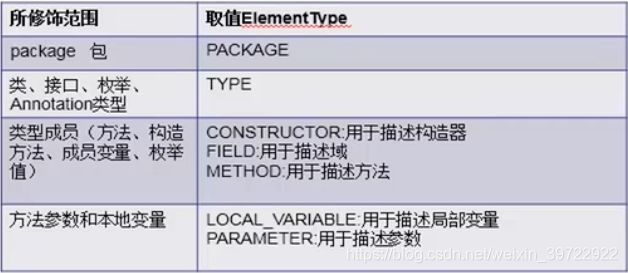注解(Annotation)
作用:
1.不是程序本身,可以对程序作出解释(这一点,跟注释没什么区别)
2.可以被其他程序(如编译器等)读取。(注解信息处理流程,是注解与注释的重大区别。如果没有注解信息处理流程,则注解毫无意义)
格式:
@注释名 还可以添加一些参数值,例如@SuppressWarnings(value="unchecked")
使用场景:
可以添加在package,class,method,field等上面,相当于添加了额外的辅助信息,我们可以通过反射机制编程实现对这些元数据的访问
常见内置注解:
@Override 表示一个方法声明打算重写超类中的另一个方法的声明
@Deprecated 表示不鼓励使用这样的元素,通常是因为它很危险或存在更好的选择、
@SuppressWarnings 用来抑制编译时的警告信息和前两个注释不同,需要添加一个参数才能正确使用
例如: @SuppressWarnings("unchecked") @SuppressWarnings(value={"unchecked","deprecation"})常见参数如下:
| 参数 | 含义 |
| deprecation | 使用了过时的类或方法警告 |
| unchecked | 执行了未检查的转换时的警告,如使用集合未指定泛型 |
| fallthrough | 在switch语句使用时发生case穿透 |
| path | 在类路径、源文件路径等中有不存在路径的警告 |
| serial | 当在可序列话的类上缺少serialVersionUID定义时 |
| finally | 任何finally子句不能完成时的警告 |
| all | 以上所有情况的警告 |
自定义注解:
在自定义注解前先了解一下元注解
元注解的作用是负责注解其他注解。java中提供了4个标准的meta-annotation类型,它们被用来提供对其他annotation类型说明
这些类型和它们所支持的类可以在java.lang.annotation包中找到
@Target @Retention @Documented @Inherited
@Target 作用:描述注解的使用范围(即被描述的注解可以用在什么地方) 例如:@Target(value=ElementType.TYPE)

@Retention 作用:表示需要在什么级别保存该注解信息,描述注解的生命周期

@Document:说明该注解将被包含在javadoc中
@Inherited:说明子类可以继承父类中的该注解
说回到自定义注解
使用@Interface自定义注解时,自动继承了java.lang.annotation.Annotation接口
要点:
1.@Interface用来声明一个注解
格式: public @interface 注解名{定义体}
2.其中的每一个方法是声明了一个配置参数
方法名称就是参数名称
返回值类型就是参数的类型(返回值类型只能是基本类型、Class、String、enum)
可以通过default声明参数中的默认值
如果只有一个参数成员,一般参数名为value
demo:自定义注解
import java.lang.annotation.ElementType;
import java.lang.annotation.Retention;
import java.lang.annotation.RetentionPolicy;
import java.lang.annotation.Target;
@Target(value= {ElementType.TYPE,ElementType.METHOD}) //表示自定义注解用在类、接口、枚举和方法前面
@Retention(RetentionPolicy.RUNTIME) //表示自定义注解在运行时有效,可以被反射机制读取
public @interface MyAnnotation {
String name(); //每一个方法声明了一个配置参数
int age() default 0; //方法名就是参数名,默认参数值为0
String[] schools ();
}
demo:测试自定义注解
public class Demo1 {
@MyAnnotation(name = "陈",schools={"学校1","学校2"})
public void show(){}
}
定义注解和使用注解的意义并不大,如何利用注解实现一些功能呢?
反射操作注解
具体反射的理解可以参考下文
我们在使用注解的时候可能会给参数设置值,提取注解针对的对象是可注解元素,做的其实有两件事:
1. 确定该元素是否被注解(标记注解只要知道是否被注解就可以了)
2. 被注解的话获取到注解的参数值
ORM框架都是在实体类的基类里面去实现ORM的功能的,所以我们这里也需要有一个实体类的基类(BaseEntity),我们会在里面提取注解,但我们现在不会在里面实现具体的数据库操作,因为我们这篇文章要讲的内容只是提取注解
以简单的学生类为例
package com.company.demo;
/**
* 学生类使用自定义注解
*/
@Table("tb_student")
public class Student {
@FieldAnnotation(columnName = "id", type = "int", length = 10)
private int id;
@FieldAnnotation(columnName = "name", type = "varchar2", length = 10)
private String name;
@FieldAnnotation(columnName = "id", type = "int", length = 3)
private int age;
public int getId() {
return id;
}
public void setId(int id) {
this.id = id;
}
public String getName() {
return name;
}
public void setName(String name) {
this.name = name;
}
public int getAge() {
return age;
}
public void setAge(int age) {
this.age = age;
}
}
自定义注解1:用来对类进行注解,使得其与数据库表对应
package com.company.demo;
/**
* 类注解
*/
import java.lang.annotation.ElementType;
import java.lang.annotation.Retention;
import java.lang.annotation.RetentionPolicy;
import java.lang.annotation.Target;
@Target(value = ElementType.TYPE)
@Retention(RetentionPolicy.RUNTIME)
public @interface Table {
String value();
}
属性注解:和数据表的字段对应
package com.company.demo;
/**
* 属性注解
*/
import java.lang.annotation.ElementType;
import java.lang.annotation.Retention;
import java.lang.annotation.RetentionPolicy;
import java.lang.annotation.Target;
@Target(value = ElementType.FIELD)
@Retention(RetentionPolicy.RUNTIME)
public @interface FieldAnnotation {
String columnName();
String type();
int length();
}
通过反射提取学生类中的注解,生成学生表
package com.company.demo;
/**
* 通过反射操作注解
*/
import java.lang.annotation.Annotation;
import java.lang.reflect.Field;
public class Demo01 {
public static void main(String[] args) {
try {
Class clazz = Class.forName("com.company.demo.Student");
//获得类的所有注解
Annotation[] annotations = clazz.getDeclaredAnnotations();
for(Annotation a:annotations){
System.out.println(a); //@com.company.demo.Table(value=tb_student)
}
//获得类的指定注解
Table t = (Table) clazz.getDeclaredAnnotation(Table.class);
System.out.println(t.value()); //tb_student
//获得属性的注解
Field idField = clazz.getDeclaredField("id");
FieldAnnotation idAnn = idField.getAnnotation(FieldAnnotation.class);
System.out.println(idAnn.columnName()+" "+idAnn.type()+" "+idAnn.length());
//之后就可以根据注解信息拼出SQL语句,使用JDBC执行SQL语句,在数据库中生成相关的表
} catch (ClassNotFoundException e) {
e.printStackTrace();
} catch (NoSuchFieldException e) {
e.printStackTrace();
}
}
}





















 2685
2685

 被折叠的 条评论
为什么被折叠?
被折叠的 条评论
为什么被折叠?








